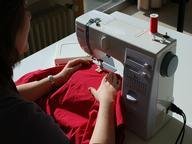Quiz Answer Key and Fun Facts
1. Depending on what level of society you're in, this era would be identified by outrageously high ruff collars, elongated, pointed waistlines, wide farthingale skirts, detachable "false" sleeves, and multiple petticoats. What period is this?
2. This era had different looks in different regions. It Italy, for example, you would see sumptuous fabrics, often prints or brocades, free-flowing skirts, puffed, detachable sleeves, and elaborate trims. What period is it?
3. This sub-category of the Edwardian era was called the Gilded Age in America. Characterized by the small waspish waist, S-shaped "pouter pigeon" silhouette, lace collars, wide shoulders and sleeves, and large hats. What was it called in Europe, most importantly in France?
4. In this period you would find layered under-and over-dresses in plain fabrics, prints, visible lacing, muted colors, aprons, cuffs and shawls. What simpler era is it?
5. Picture it: the French court. Wide pannier skirts, ruffles aplenty, silks, satins, bows, brocades, rich colors. A most over-the-top fashion period with hairstyles to match. With the later Rococo period, the panniers reached their widest point. What era are we in?
6. This period was probably the simplest in terms of women's fashion. Very high Empire waistline - just under the breast, straight free-flowing skirts and bonnets. When is it?
7. This decade of decadence saw the waistline go in the opposite direction from the Empire....way down past the hips. Straight sheath skirts, feathers, beads, fringes, close-fitting hats, and short bobbed hair. What period is it?
8. Probably the most easily-identified period. You would see corseted dresses with crinoline or hoop skirts, lace, ruffles, off the shoulder necklines, and bonnets or hats. The iconic Queen set the fashion. What was it?
9. In this early period you would find under-dresses called a chemise or chainse, with an overskirt called a kirtle. There was often visible lacing at the front or sides, and long, flowing trumpet sleeves. A long belt or girdle would complete the ensemble and a veil or hood over the hair. Looking like this you would fit right in at King Arthur's court. What period is it?
10. This period might sometimes be called the Late Victorian era. Early on, this was the arrival of the bustle, the outrageously tiny corseted waist, parasols, walking sticks, and opulent wide hats. The latter part saw the invention of the "walking dress", an ankle-length hem that didn't drag on the ground. When is it?
Source: Author
DaltreyFan
This quiz was reviewed by FunTrivia editor
kyleisalive before going online.
Any errors found in FunTrivia content are routinely corrected through our feedback system.

